
Xanthidae is a family of crabs known as gorilla crabs, mud crabs, pebble crabs or rubble crabs. Xanthid crabs are often brightly coloured and are highly poisonous, containing toxins which are not destroyed by cooking and for which no antidote is known. The toxins are similar to the tetrodotoxin and saxitoxin produced by puffer fish, and may be produced by bacteria in the genus Vibrio living in symbiosis with the crabs, mostly V. alginolyticus and V. parahaemolyticus.

Xanthoidea is a superfamily of crabs, comprising seven families. Formerly, a number of other families were included in Xanthoidea, but many of these have since been removed to other superfamilies. These include Carpilioidea, Eriphioidea, Hexapodoidea, Pilumnoidea and Trapezioidea. Even in this reduced state, Xanthoidea remains one of the most species-rich superfamilies of crabs.
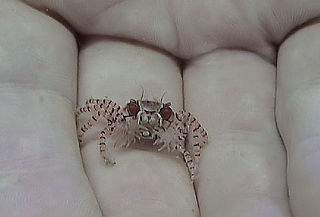
Lybia is a genus of small crabs in the family Xanthidae. Their common names include boxer crabs, boxing crabs and pom-pom crabs. They are notable for their mutualism with sea anemones, which they hold in their claws for defense. In return, the anemones get carried around, which may enable them to capture more food particles with their tentacles. Boxer crabs use at least three species of anemones, including Bundeopsis spp. and Triactis producta. The bonding with the anemone is not needed for survival, however, and boxer crabs have frequently been known to live without them, sometimes substituting other organisms such as sponges and corals for the sea anemones.

Actumnus is a genus of crabs in the family Pilumnidae. Alongside the 28 extant species, it has a fossil record extending back into the Miocene.
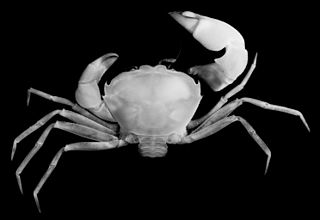
Pseudozioidea is a superfamily of crabs, formerly treated in the Eriphioidea, Carpilioidea, Xanthoidea, Pilumnoidea and Goneplacoidea. A number of fossils from the Eocene onwards are known from the family Pseudoziidae. Eleven genera are recognised in three families:

Zosimus aeneus, also known as the devil crab, toxic reef crab, and devil reef crab is a species of crab that lives on coral reefs in the Indo-Pacific from East Africa to Hawaii. It grows to a size of 60 mm × 90 mm and has distinctive patterns of brownish blotches on a paler background. It is potentially lethal due to the presence of the neurotoxins tetrodotoxin and saxitoxin in its flesh and shell.

Epiactaea is a genus of crabs in the family Xanthidae, containing the following species:
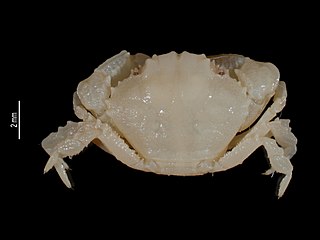
Paramedaeus is a genus of crabs in the family Xanthidae, containing the following species:
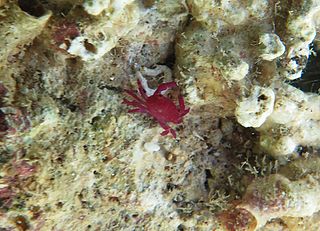
Liomera is a genus of crabs in the family Xanthidae. It contains the following species:

Neoliomera is a genus of crabs in the family Xanthidae, containing the following species:
Odhnea is a genus of crabs in the family Xanthidae, containing the following species:
Pseudactaea is a genus of crabs in the family Xanthidae, containing the following species:
Serenius is a genus of crabs in the family Xanthidae, containing the following species:
Crosnierius is a genus of crabs in the family Xanthidae, containing the following species:
Actiomera is a genus of crabs in the family Xanthidae, containing the following species:
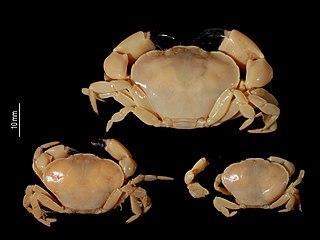
Euryxanthops is a genus of crabs in the family Xanthidae. It was originally established in 1983 by Garth & Kim to contain three species of deep-water crabs from Japan and the Philippines - Euryxanthops dorsiconvexus, Euryxanthops flexidentatus and Euryxanthops orientalis. Since then, several more species of this genus have been identified and described, and Euryxanthops currently contains:
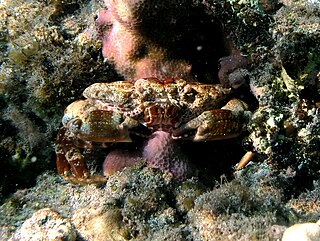
Neoxanthias is a genus of crabs in the family Xanthidae, containing the following species:
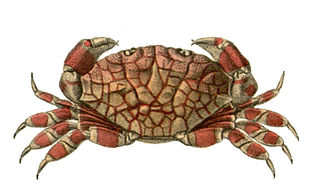
Lophozozymus is a genus of crabs in the family Xanthidae, containing the following species:

Mathildellidae is family of crabs belonging to the superfamily Goneplacoidea, containing the following genera:

Gordonopsis is a genus of deep-sea porter crabs in the family Homolidae. The Homolidae are also known as carrier crabs or porter crabs for their fifth pereiopods, which they use to hold objects in place over the rear half of the carapace in a possible defence mechanism against predators. Species of Gordonopsis are found in deep waters of the Indo-West Pacific region. The genus was erected in 1995 by Danièle Guinot and Bertrand Richer de Forges.














